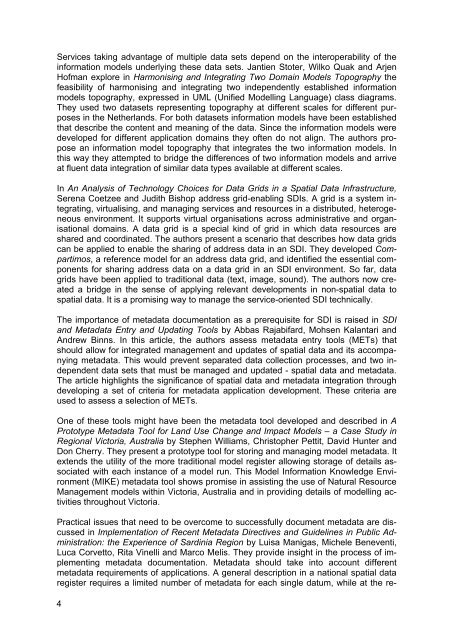SDI Convergence - Global Spatial Data Infrastructure Association
SDI Convergence - Global Spatial Data Infrastructure Association
SDI Convergence - Global Spatial Data Infrastructure Association
Create successful ePaper yourself
Turn your PDF publications into a flip-book with our unique Google optimized e-Paper software.
Services taking advantage of multiple data sets depend on the interoperability of the<br />
information models underlying these data sets. Jantien Stoter, Wilko Quak and Arjen<br />
Hofman explore in Harmonising and Integrating Two Domain Models Topography the<br />
feasibility of harmonising and integrating two independently established information<br />
models topography, expressed in UML (Unified Modelling Language) class diagrams.<br />
They used two datasets representing topography at different scales for different purposes<br />
in the Netherlands. For both datasets information models have been established<br />
that describe the content and meaning of the data. Since the information models were<br />
developed for different application domains they often do not align. The authors propose<br />
an information model topography that integrates the two information models. In<br />
this way they attempted to bridge the differences of two information models and arrive<br />
at fluent data integration of similar data types available at different scales.<br />
In An Analysis of Technology Choices for <strong>Data</strong> Grids in a <strong>Spatial</strong> <strong>Data</strong> <strong>Infrastructure</strong>,<br />
Serena Coetzee and Judith Bishop address grid-enabling <strong>SDI</strong>s. A grid is a system integrating,<br />
virtualising, and managing services and resources in a distributed, heterogeneous<br />
environment. It supports virtual organisations across administrative and organisational<br />
domains. A data grid is a special kind of grid in which data resources are<br />
shared and coordinated. The authors present a scenario that describes how data grids<br />
can be applied to enable the sharing of address data in an <strong>SDI</strong>. They developed Compartimos,<br />
a reference model for an address data grid, and identified the essential components<br />
for sharing address data on a data grid in an <strong>SDI</strong> environment. So far, data<br />
grids have been applied to traditional data (text, image, sound). The authors now created<br />
a bridge in the sense of applying relevant developments in non-spatial data to<br />
spatial data. It is a promising way to manage the service-oriented <strong>SDI</strong> technically.<br />
The importance of metadata documentation as a prerequisite for <strong>SDI</strong> is raised in <strong>SDI</strong><br />
and Metadata Entry and Updating Tools by Abbas Rajabifard, Mohsen Kalantari and<br />
Andrew Binns. In this article, the authors assess metadata entry tools (METs) that<br />
should allow for integrated management and updates of spatial data and its accompanying<br />
metadata. This would prevent separated data collection processes, and two independent<br />
data sets that must be managed and updated - spatial data and metadata.<br />
The article highlights the significance of spatial data and metadata integration through<br />
developing a set of criteria for metadata application development. These criteria are<br />
used to assess a selection of METs.<br />
One of these tools might have been the metadata tool developed and described in A<br />
Prototype Metadata Tool for Land Use Change and Impact Models – a Case Study in<br />
Regional Victoria, Australia by Stephen Williams, Christopher Pettit, David Hunter and<br />
Don Cherry. They present a prototype tool for storing and managing model metadata. It<br />
extends the utility of the more traditional model register allowing storage of details associated<br />
with each instance of a model run. This Model Information Knowledge Environment<br />
(MIKE) metadata tool shows promise in assisting the use of Natural Resource<br />
Management models within Victoria, Australia and in providing details of modelling activities<br />
throughout Victoria.<br />
Practical issues that need to be overcome to successfully document metadata are discussed<br />
in Implementation of Recent Metadata Directives and Guidelines in Public Administration:<br />
the Experience of Sardinia Region by Luisa Manigas, Michele Beneventi,<br />
Luca Corvetto, Rita Vinelli and Marco Melis. They provide insight in the process of implementing<br />
metadata documentation. Metadata should take into account different<br />
metadata requirements of applications. A general description in a national spatial data<br />
register requires a limited number of metadata for each single datum, while at the re-<br />
4

















